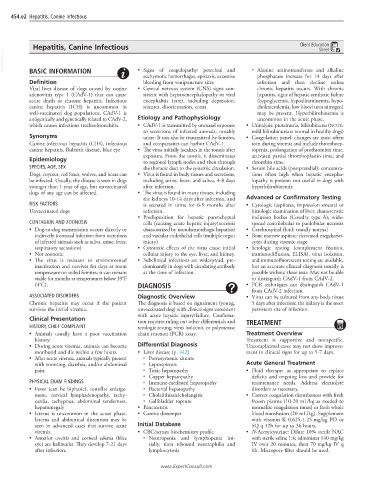Page 928 - Cote clinical veterinary advisor dogs and cats 4th
P. 928
454.e2 Hepatitis, Canine Infectious
Hepatitis, Canine Infectious Client Education
Sheet
VetBooks.ir
BASIC INFORMATION
• Signs of coagulopathy: petechial and
ecchymotic hemorrhages, epistaxis, excessive ○ Alanine aminotransferase and alkaline
phosphatase increase for 14 days after
Definition bleeding from venipuncture sites infection and then decline unless
Viral liver disease of dogs caused by canine • Central nervous system (CNS) signs con- chronic hepatitis occurs. With chronic
adenovirus type 1 (CAdV-1) that can cause sistent with hepatoencephalopathy or viral hepatitis, signs of hepatic synthetic failure
acute death or chronic hepatitis. Infectious encephalitis (rare), including depression, (hypoglycemia, hypoalbuminemia, hypo-
canine hepatitis (ICH) is uncommon in seizures, disorientation, coma cholesterolemia, low blood urea nitrogen)
well-vaccinated dog populations. CAdV-1 is may be present. Hyperbilirubinemia is
antigenically and genetically related to CAdV-2, Etiology and Pathophysiology uncommon in the acute phase.
which causes infectious tracheobronchitis. • CAdV-1 is transmitted by oronasal exposure • Urinalysis: proteinuria, bilirubinuria (NOTE:
to secretions of infected animals, notably mild bilirubinuria is normal in healthy dogs)
Synonyms urine. It can also be transmitted by fomites, • Coagulation panel: changes are most often
Canine infectious hepatitis (CIH), infectious and ectoparasites can harbor CAdV-1. seen during viremia and include thrombocy-
canine hepatitis, Rubarth disease, blue eye • The virus initially localizes in the tonsils after topenia, prolongation of prothrombin time,
exposure. From the tonsils, it disseminates activated partial thromboplastin time, and
Epidemiology to regional lymph nodes and then through thrombin time.
SPECIES, AGE, SEX the thoracic duct to the systemic circulation. • Serum bile acids (postprandial): concentra-
Dogs, coyotes, red foxes, wolves, and bears can • Virus is found in body tissues and secretions, tions often high when hepatic encepha-
be infected. Usually, the disease is seen in dogs including urine, feces, and saliva, 4-8 days lopathy is present; not useful in dogs with
younger than 1 year of age, but unvaccinated after infection. hyperbilirubinemia
dogs of any age can be affected. • The virus is found in many tissues, including
the kidneys 10-14 days after infection, and Advanced or Confirmatory Testing
RISK FACTORS is secreted in urine for 6-9 months after • Cytologic (aspirates, impression smears) or
Unvaccinated dogs infection. histologic examination of liver: characteristic
• Predisposition for hepatic parenchymal inclusion bodies (Cowdry type A); wide-
CONTAGION AND ZOONOSIS cells (causing acute hepatic injury/necrosis spread centrilobular to panlobular necrosis
• Dog-to-dog transmission occurs directly or characterized by necrohemorrhagic hepatitis) • Cerebrospinal fluid: usually normal
indirectly (oronasal infection from secretions and vascular endothelial cells (multiple organ • Bone marrow aspirate: decreased megakaryo-
of infected animals such as saliva, urine, feces, injury) cytes during viremic stage
respiratory secretions) • Cytotoxic effects of the virus cause initial • Serologic testing (complement fixation,
• Not zoonotic cellular injury to the eye, liver, and kidney. immunodiffusion, ELISA), virus isolation,
• The virus is resistant to environmental • Subclinical infections are widespread, pre- and immunofluorescent testing are available,
inactivation and survives for days at room dominantly in dogs with circulating antibody but an accurate clinical diagnosis usually is
temperature on soiled fomites; it can remain at the time of infection. possible without these tests. May not be able
viable for months at temperatures below 39°F to distinguish CAdV-1 from CAdV-2.
(4°C). DIAGNOSIS • PCR techniques can distinguish CAdV-1
from CAdV-2 infection.
ASSOCIATED DISORDERS Diagnostic Overview • Virus can be cultured from any body tissue
Chronic hepatitis may occur if the patient The diagnosis is based on signalment (young, 5 days after infection; the kidney is the most
survives the initial viremia. unvaccinated dog) with clinical signs consistent persistent site of infection.
with acute hepatic injury/failure. Confirma-
Clinical Presentation tion requires ruling out other differentials and
HISTORY, CHIEF COMPLAINT serologic testing, virus isolation, or polymerase TREATMENT
• Animals usually have a poor vaccination chain reaction (PCR) assay. Treatment Overview
history. Treatment is supportive and nonspecific.
• During acute viremia, animals can become Differential Diagnosis Uncomplicated cases may not show improve-
moribund and die within a few hours. • Liver disease (p. 442) ment in clinical signs for up to 5-7 days.
• After acute viremia, animals typically present ○ Portosystemic shunts
with vomiting, diarrhea, and/or abdominal ○ Leptospirosis Acute General Treatment
pain. ○ Toxic hepatopathy • Fluid therapy: as appropriate to replace
○ Copper hepatopathy deficits and ongoing loss and provide for
PHYSICAL EXAM FINDINGS ○ Immune-mediated hepatopathy maintenance needs. Address electrolyte
• Fever (can be biphasic), tonsillar enlarge- ○ Bacterial hepatopathy disorders as necessary.
ment, cervical lymphadenopathy, tachy- ○ Cholelithiasis/cholangitis • Correct coagulation disturbances with fresh
cardia, tachypnea, abdominal tenderness, ○ Gallbladder rupture frozen plasma (10-20 mL/kg as needed to
hepatomegaly • Pancreatitis normalize coagulation times) or fresh whole
• Icterus is uncommon in the acute phase. • Canine distemper blood transfusion (20 mL/kg). Supplement
Icterus and abdominal distention may be with vitamin K 0.625-1.25 mg/kg PO or
seen in advanced cases that survive acute Initial Database SQ q 12h for up to 36 hours.
viremia. • CBC/serum biochemistry profile • N-Acetylcysteine: Dilute 10% sterile NAC
• Anterior uveitis and corneal edema (blue ○ Neutropenia and lymphopenia ini- with sterile saline 1:4; administer 140 mg/kg
eye) are hallmarks. They develop 7-21 days tially, then rebound neutrophilia and IV over 20 minutes, then 70 mg/kg IV q
after infection. lymphocytosis 6h. Micropore filter should be used.
www.ExpertConsult.com

